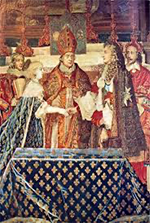The Franco-Spanish War: 17th-Century Fight for Supremacy
France and Spain fought a number of wars against each other through the centuries. One of the most pivotal was known as the Franco-Spanish War and occurred in the 17th Century, against the backdrop of the Continent-wide conflict known as the Thirty Years War. Spain and the Netherlands were fighting the Eighty Years War, which began in 1568, when the Spanish monarch was Philip II. The two sides had fought each other to a standstill and had signed a truce, which was to expire in 1621. The Thirty Years War began in 1618 and soon enveloped most of Europe. Fighting on opposite sides were Catholic Spain and a collection of Protestant Dutch provinces known as the Dutch Republic. The Spanish monarch by this time was Philip IV. France, under the well-known Louis XIII and his most trusted advisor, Cardinal Richelieu, had sent large amounts of money to aid the Protestant forces in the early years of the war. A resurgence of Huguenot discontent within French borders had forced French troops to focus on internal concerns. By 1630, however, royal troops were again in control of the countryside. France signed treaties with both Bavaria (to provide both money and troops) and Sweden (to provide money). Each side scored a number of victories; some truces, such as the 1635 Peace of Prague, stopped the fighting for a time. The fighting was back on in that same year as French sent troops to the front. King and Cardinal were Catholic but sided with the Protestants in order to oppose Ferdinand II. Richelieu feared that a Holy Roman Empire victory would leave France encircled by forces loyal to Spain. Thus, the war between France and Spain began, as part of a wider conflict. In the waning days of the wider conflict, a large French force had moved into the Spanish Netherlands and, after defeating a Spanish defense contingent, joined up with a Dutch force. Spain turned the tables on this advance, marching into northern France before retreating over the border again. 
On the war went. In 1648, a French force under Louis II de Bourbon, Prince de Condé defeated the Spanish at the Battle of Lens. Elsewhere, a Swedish force captured Prague Castle. Catholic forces wanted to fight on but were well and truly exhausted. Protestant forces shared their pain. Finally, four years of negotiations produced the Peace of Westphalia, which technically ended the wide war between Catholics and Protestants. The twin treaties that made up the Peace did not, however, bring peace in the case of France versus Spain. Those two countries continued to fight each other. Spain had earlier fought against rebellions in both Catalonia and Portugal during the Thirty Years War. With the wider conflict finished, Spain could focus on France. Coinciding with the end of the wider war was an uprising in France known as the Fronde. The French government had introduced a host of new and higher taxes, to which many leading Parisians objected. A large number of discontented workers turned to a low level of violence, taking out their frustrations with the taxes by flinging stones at the window's of the associates of Chief Minister Cardinal Jules Mazarin. Mazarin responded with a heavy hand, arresting the leaders of the movement after the parlement had moved to revoke the king's authority and refused to allow new taxes. (The arrests occurred on the same day as a celebration of France's significant victory over Spain at the Battle of Lens.) The response was more violence, as Paris descended into riots and barricaded streets. The timing of the uprising was such that the large majority of French troops were still in the field. This continued to be the case, to a lesser extent, after the end Peace of Westphalia because French troops were focused on the Spanish. Outbreaks of violence continued for the next handful of years, until French troops finally ended the Fronde in the summer of 1653. France carried on the war effort, winning a significant victory at Arras and then flooding Flanders with French troops, sending the Spanish reeling. On the other side, Spain claimed victories at Pavia and in Lombardy. France, with no plentiful navy to call its own, hammered out an alliance with England in 1657, and English troops and ships were fighting on the side of the French (a not all that common occurrence). France and Spain also battled for control of Northern Italy, with Spain winning a significant in Lombardy in the waning stages of the war and turning back a determined attempt by French allies Modena and Savoy to seize control of Spanish-controlled Milan. 
A joint English-French attack in 1658 took control of the port city of Dunkirk, and Spain asked for peace. Mazarin initially refused but, seeing the possible end of the alliance with England because of political upheaval there, eventually agreed. The two major powers began negotiating on May May 8, 1659, and signed the Peace of the Pyrenees on November 5 of that same year. In an occurrence that was becoming increasingly rare, the two monarchs, Louis XIV and Philip IV, met, on the Isle of Pheasants, the following year, to officially seal the deal. France gained some territory as a result of the peace agreement. Artois and Hainaut moved from the Spanish Netherlands into the boundaries of France, as did Roussilon, otherwise known as northern Catalonia. To seal the deal, the French king, Louis XIV married Maria Theresa, the daughter of King Philip IV of Spain.
|
|
Social Studies for Kids
copyright 2002–2025
David White




